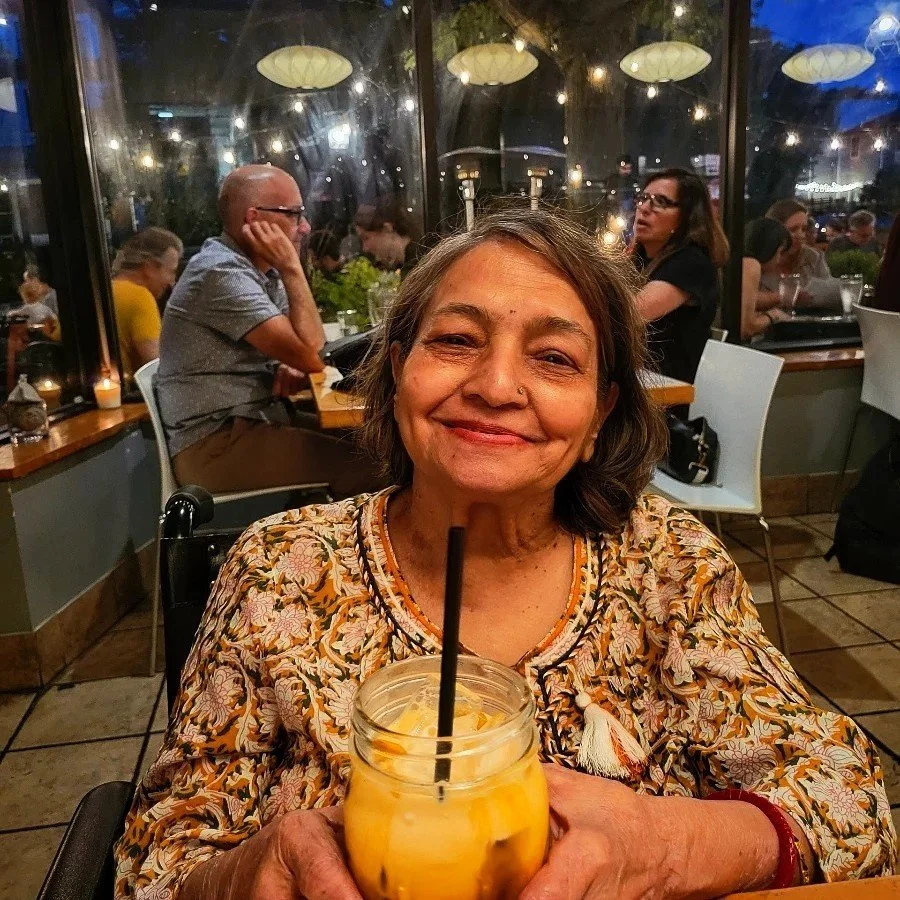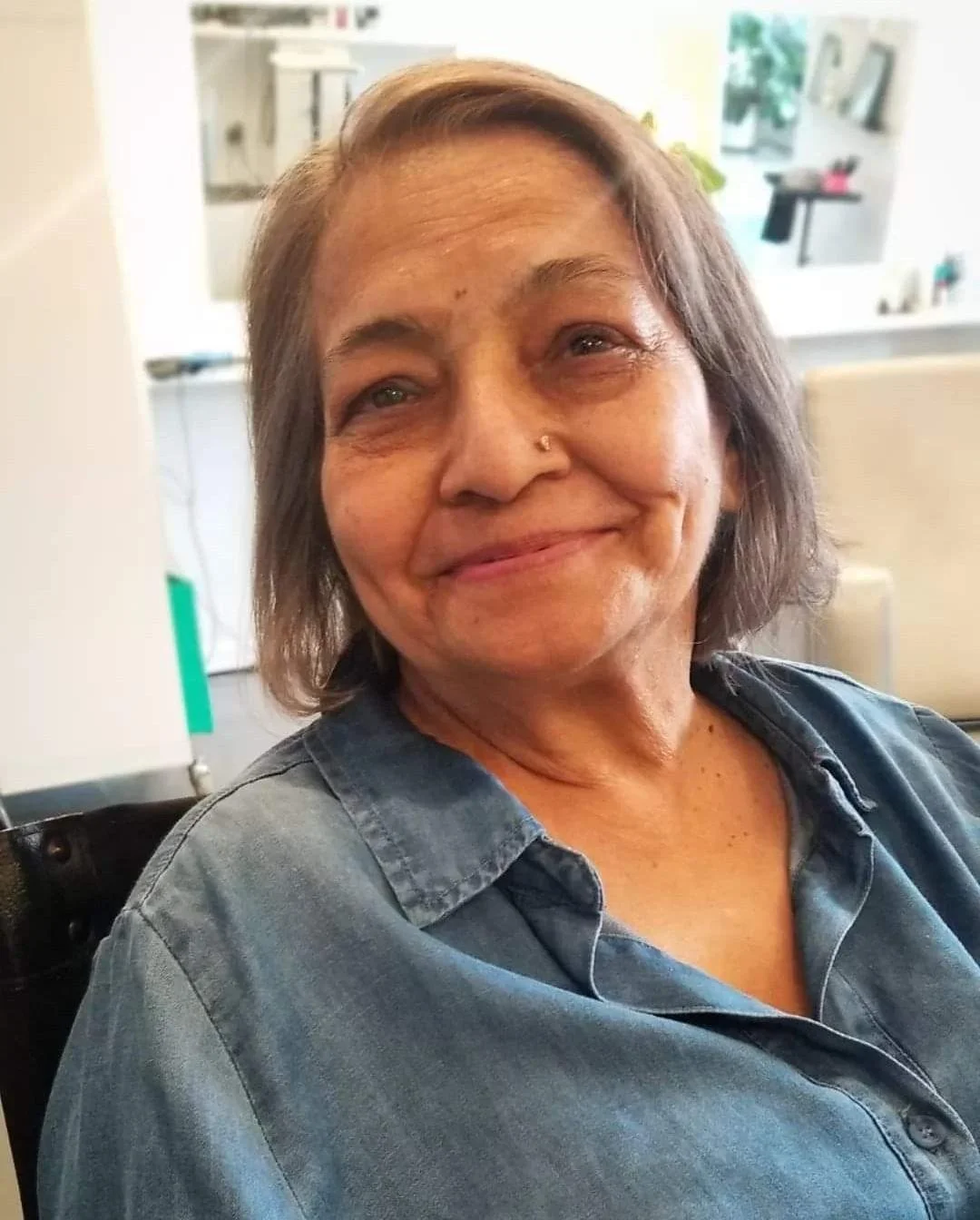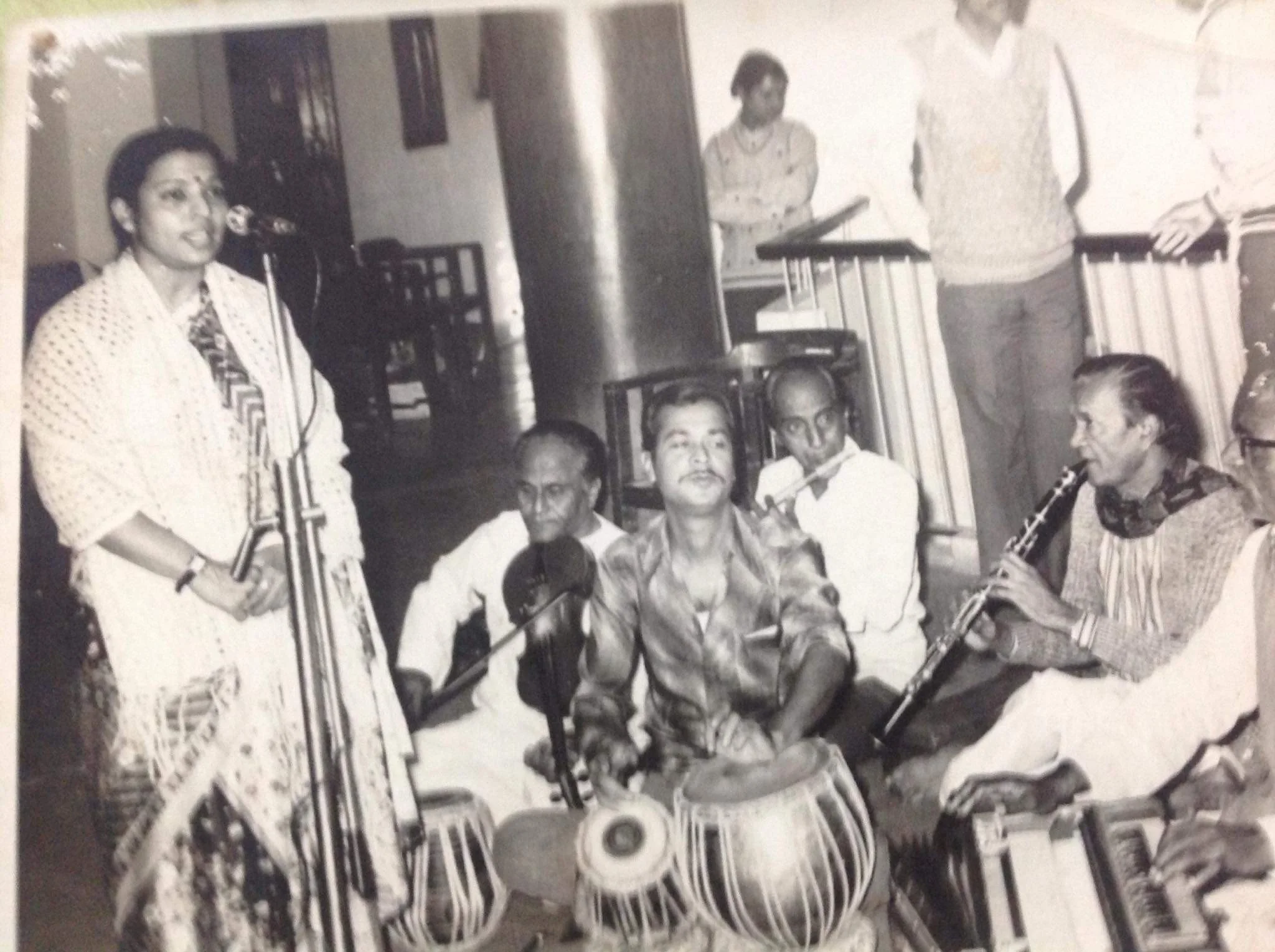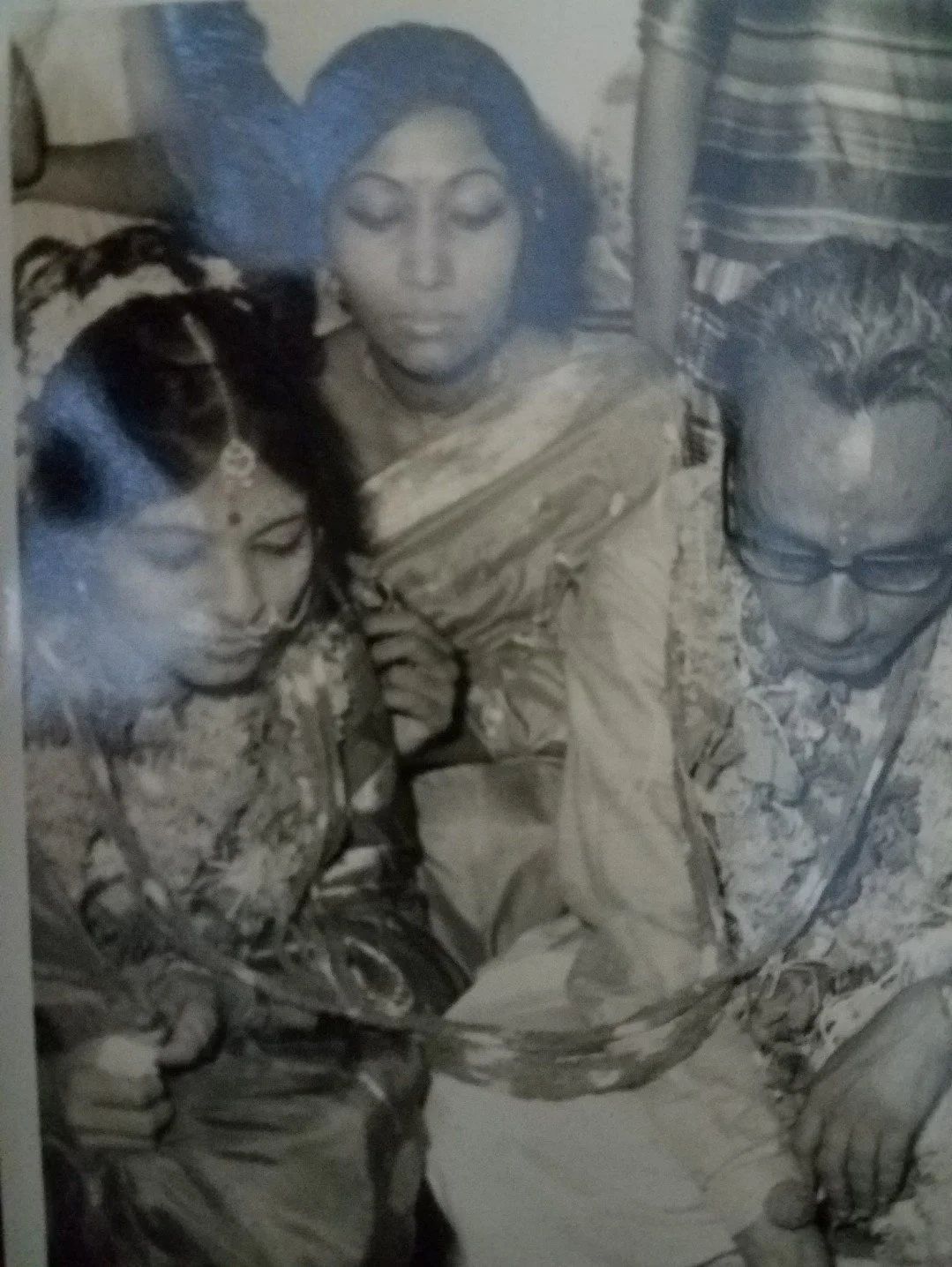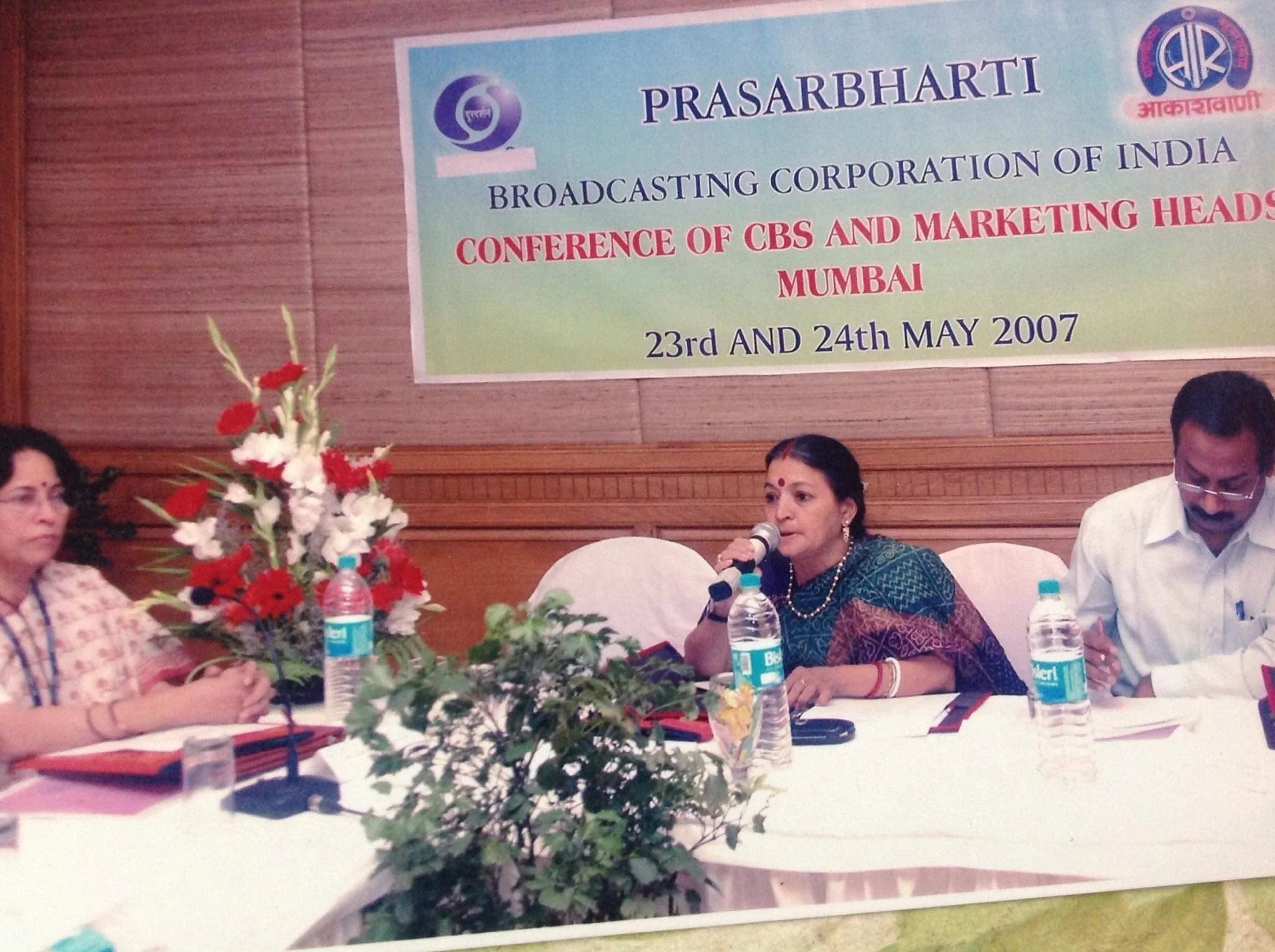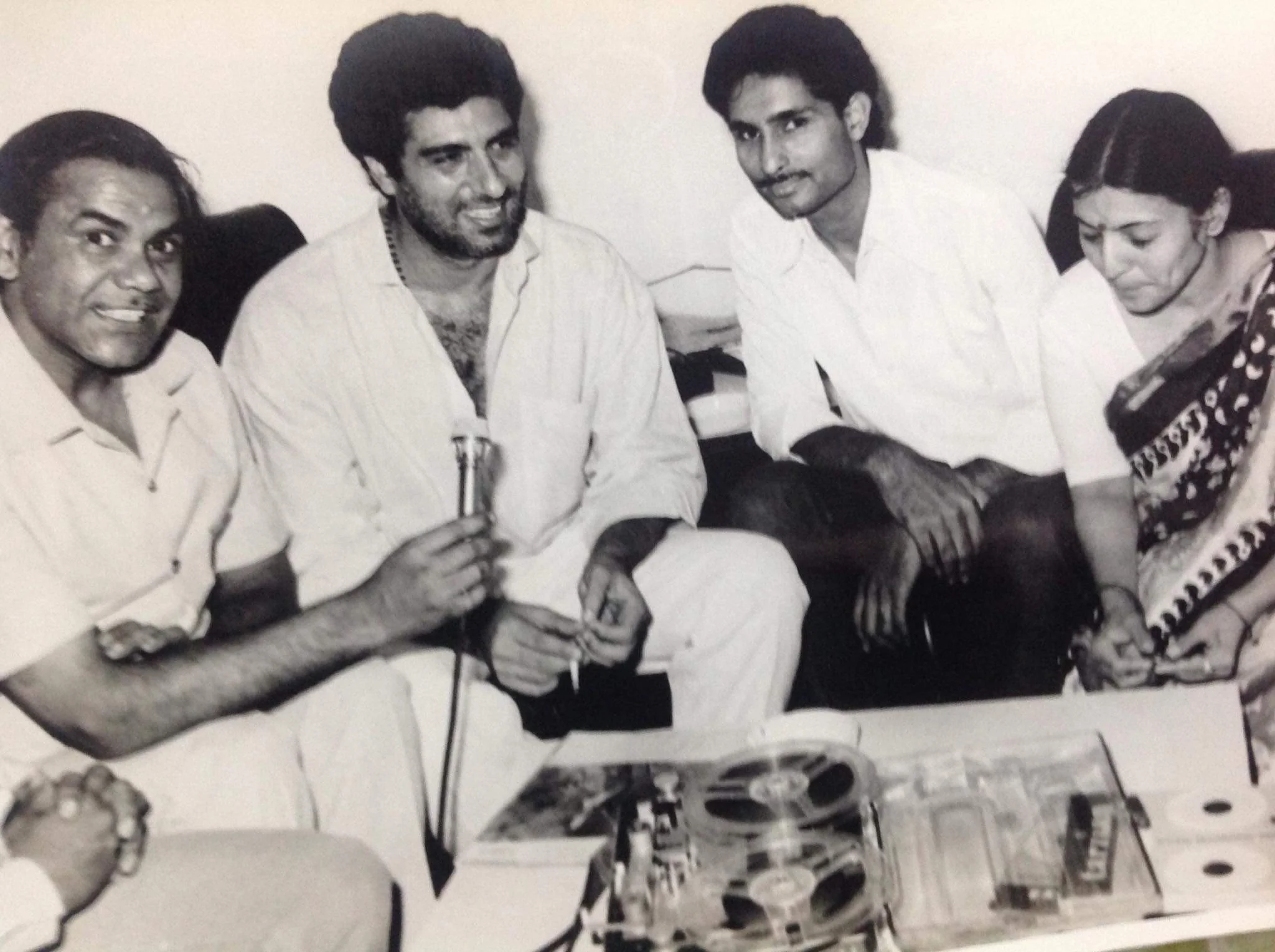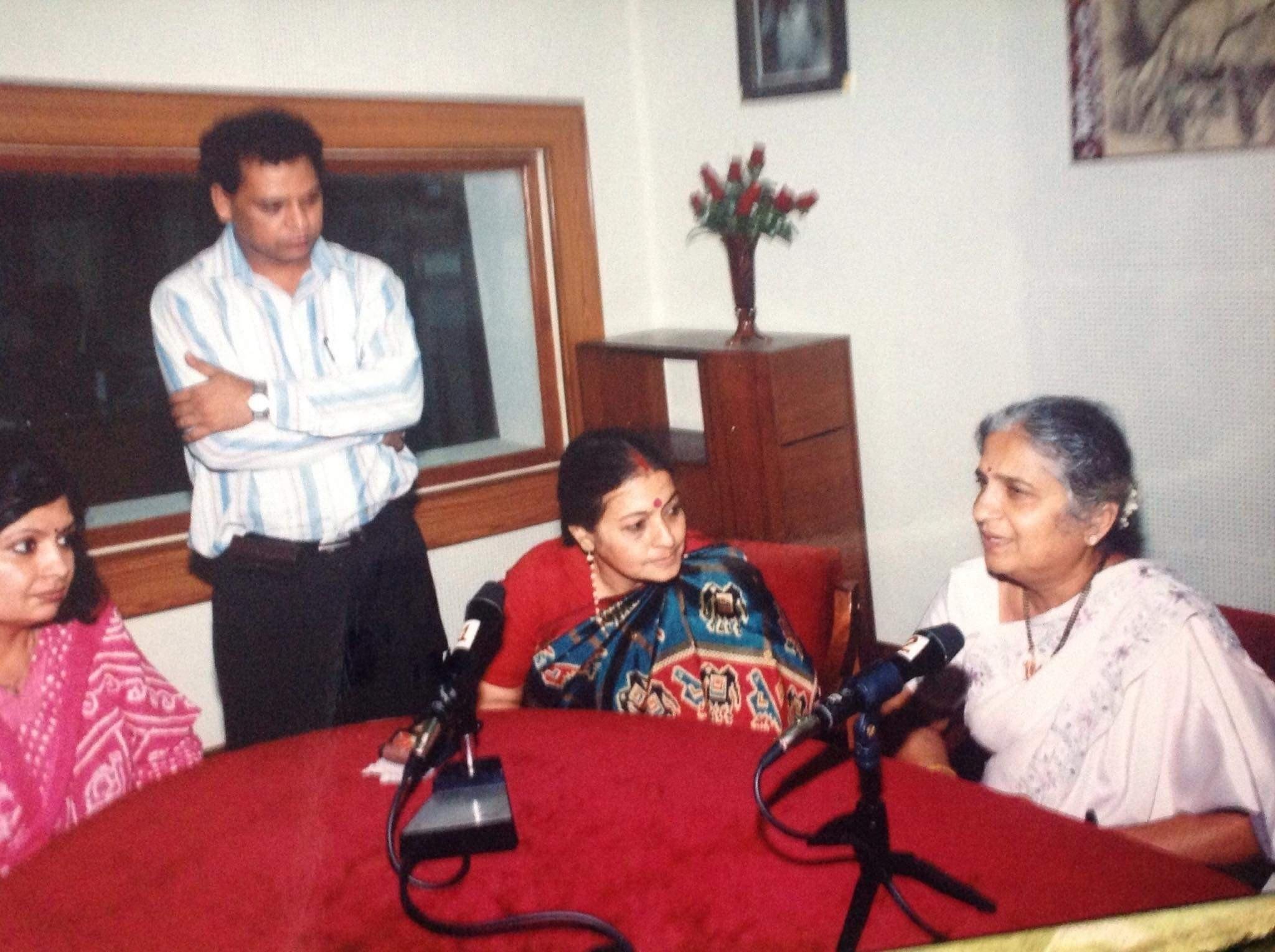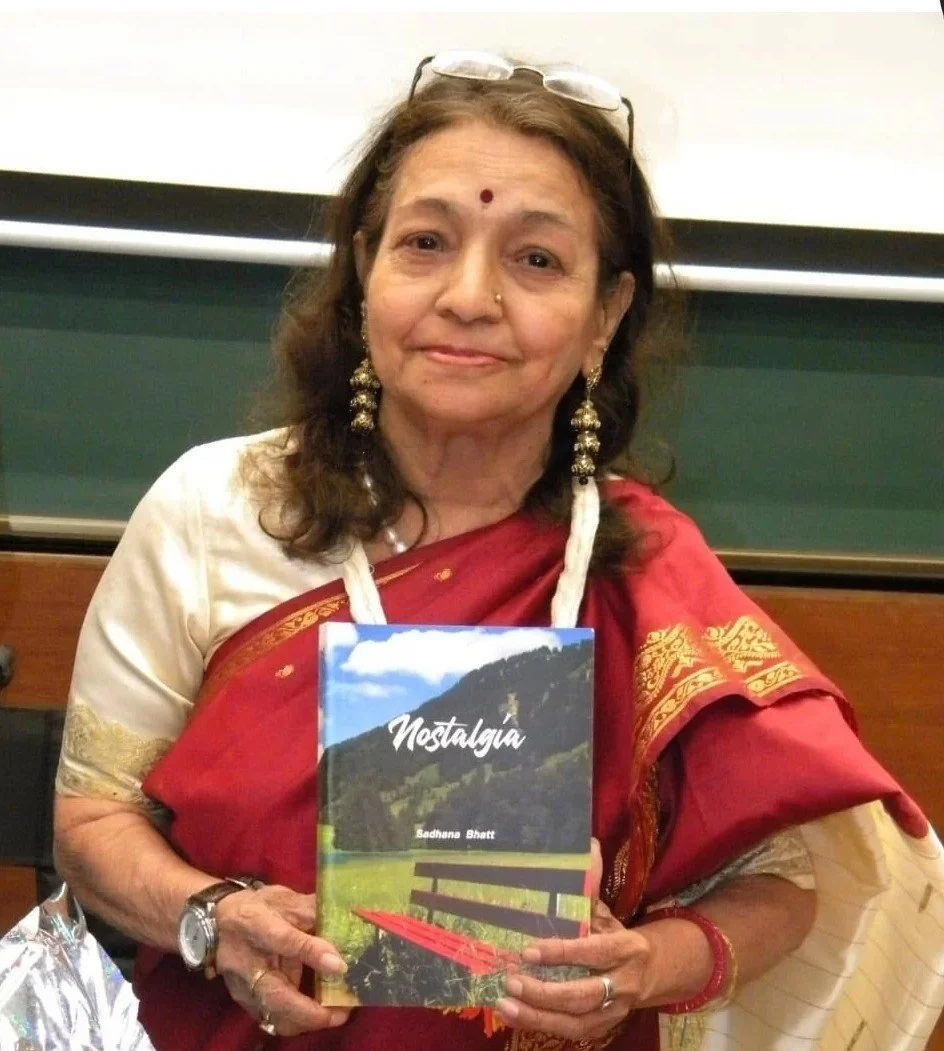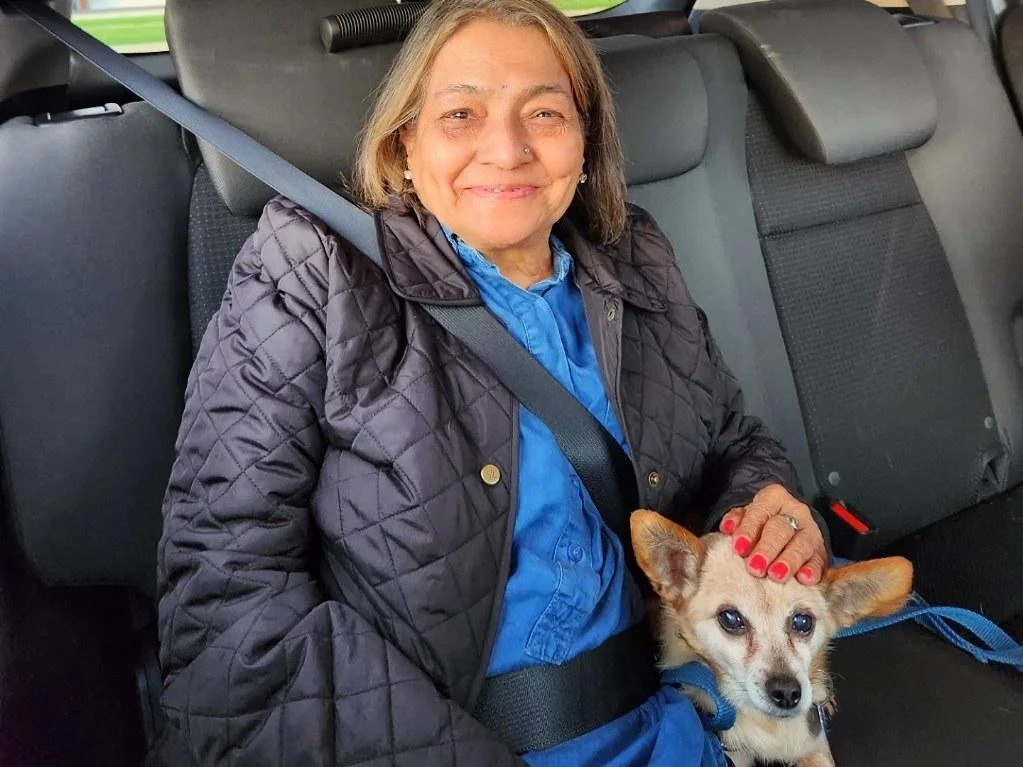Sadhana Bhatt
As I start writing this interview, I realize that the cultural twinge of discomfort of referring to someone older by their first name only is strong – some habits are too deeply wired. I met Sadhana (Saa-dh-naa Aunty, my brain immediately chastises), my wonderful friend Surabhi’s mother at a party Surabhi hosted. Surabhi had joked that there would be story time with mom at the party; little did I know how interesting that time would be and how fast it would fly by. I knew then I had to come back before she left for India, and managed to convince them to squeeze me in during one of the last evenings of the trip.
I will acknowledge the obvious: I am in awe and full of joy from learning about a life so richly lived. It starts, as do so many Indian family histories, from the times of British colonization, when her grandfather was a zamindaar (landlord), who owned a considerable amount of land in the Kachrapara area of West Bengal. But when the British annexed the region, the family had to pack up and flee to the other side of the country – Ajmer, Rajasthan, losing much of their fortunes in the process. This was the time when the struggle for independence was hurtling towards its inevitable success, and the British were even more violent and exploitative (I imagine the last desperate actions of losing).
When not working, her grandfather was a musician who enjoyed singing and playing; his fellow musicians included the Maihar Gharana and Baba Allaudin Khan – guru of Ravi Shankar – all maestros in the field of music. While tensions awere high at this time (primarily stoked by the British) and Brahmin women kept purdah (social practice of female seclusion from men that were not family), visits by the esteemed musicians of the community helped the family build legitimacy and safety in their new community.
After Independence, her grandfather ensured all his children received an education, even sending them across India if needed despite the tumultuous times of a newly independent India and the partition. This is how Sadhana’s father was able to complete his Masters at the University of Baroda, which she recognizes as a key turning point in the family’s fortunes. Her father went on to become an Executive Engineer in the Indian Railways, his work involving supervising the construction of bridges over rivers and mountains across the country. The family moved all over India as he was transferred to cities like Udaipur, Bandikui, Mumbai, and Valsad, and she reminisces about the happy memories of vacations in open tents under the stars, riding on camels, and jumping in shallow rivers. Despite all the relocations, her father made sure that all his childrens’ education was prioritized and that they received the best education - which at the time could be mostly found in convent or central schools.
Recording A Patriotic Song
As a result of her early exposure to music through her grandfather, music is a constant theme in her life. She began singing at the age of 5 at a local Saraswati puja (a festival that honors the goddess Saraswati and marks the arrival of Spring) that the family attended yearly. She recollects that while she wasn’t registered to perform, she stood up and boldly declared that she would like to sing. She then sang a Meera bhajan (Meera was a 16th century Hindu mystic poet whose devotional hymns (bhajans) were famous across India) and which her favorite aunt, Puta (puh-taa), used to sing. Puta was like a second mother to Sadhana and would take care of her, and often sang to her. She was also an excellent singer – another example of the musical talent running in the family. But in those days there were no avenues for women to perform, and at 20, she was married into a large family and moved away to a different city. However, given Sadhana’s aptitude and love for singing and music, Sadhana’s father found her a music tutor, who taught her vocal Indian classical music till she was about 16 years of age.
Sadhana then went on to do her BSc at Sophia College (a prestigious educational institution) in Ajmer, and subsequently applied for a Pre Medical Test that would allow her to secure admission to a medical college. She found out in late November 1977 that she had successfully secured a spot at a medical college. It is important to call out here that this was quite ground breaking in itself; women during this time in India were often excluded from the profession. But days after, she received the heart breaking news that her father had passed away suddenly due to a heart attack, leaving her and the entire family – her sister, two brothers, mother, and a male cousin (who her parents raised as a son) needing to move in with her uncle and his family in the city of Ajmer from where they were living in the city of Valsad. When she broached the topic of her medical school admission to her uncle (now the financial head of the family unit), her uncle adamantly refused to support her financially.
Forced to abandon her dreams of becoming a doctor, Sadhana realized that she would need a different path – one where she could support her younger siblings financially so that they could pursue their dreams. She recalls she made this decision very quickly, almost overnight - a style of decision making that sticks with her to this day, even if it has involved making many blunders along the way. That night she decided that she would find a job, and build a life for her family which was separate from her uncle and aunt. The next day she approached the Principal of Sophia College, and told her that she needed a job. She started to teach Math and Science to grades 1-5, doing this for 2 years, which she really enjoyed. She also used this time to get a MA in English literature and music.
She then went on to work as an English lecturer at TSR Arts and Commerce college in the city of Patan in the state of Gujarat. She tells the story of her students, many of whom were the sons of rich families but who did not want to be like their fathers – farmers and landowners; they wanted to be a part of the workforce in the “new India” - through the Indian Administrative Service (IAS) or the growing financial industry & banking systems. This led her to suggest that the college start a special evening class for the group so that they could develop their English skills enough to sit for competitive exams for banks, railway, or other government jobs - a move that put her at the helm of the evening program, doubling her salary. This also helped her continue supporting everyone else’s education in her family – her brother’s college education in Allahabad that included hostel expenses, her sister’s college education in Ajmer, money to support her mother’s household expenses, and more.
Wedding
It was also at TSR Arts and Commerce college that she would meet her husband Arun (uh-roon), while she was teaching classes to students in the Arts division. Interestingly, he had been on the committee that had originally selected her for the position. They quickly bonded over their love for books, music, and theater - all areas Arun was very active in. In fact, he had led an underground social resistance theater to support the Indian independence movement throughout his younger years. After they married in 1975, she resigned from her role at TSR college and moved to the city of Ahmedabad where Arun’s very elderly parents were moving to and where her elder sister-in-law lived. In Ahmedabad she started teaching blind students in grades 10, 11 and 12 at the Blind People’s Association. In 1976 she had her first child - Bhuvanesh.
At A Prasarbharti Conference In 2007
Similar to the many students she taught, Sadhana also had a dream to be a part of the newly independent India and contribute to its prosperity and growth. In 1980 she took and successfully cleared the prestigious and highly competitive Union Public Services Commission (UPSC)’s civil services exam. Her father-in-law saw a newspaper advertisement for a gazetted post (executive/managerial level ranked government role) in the Ministry of Information and Broadcasting, and encouraged her to apply. By now it should come as no surprise that she successfully got through all the steps of the rigorous examination and interview process and was hired as a Program Executive at All India Radio (AIR) to plan, coordinate, convene, and conduct all recording, production, and broadcast of local and national news and stories - this included national plays, invited audience programs, and all musical programs. It is hard to fully describe the constant reliable presence and trustworthiness AIR had in the lives of millions of Indians across the nation. In the newly independent India, it was the primary source of communication and information for people across India, not just in cities but also in towns and villages; as much for the office worker as for the farmer. With a network of over 250 radio stations and broadcasting in 23 languages and 146 dialects, AIR today is accessible to almost the entire population of India and successfully reaches a vast spectrum of socioeconomically and culturally diverse populace. In 1986, her second child - Surabhi was born.
She reflects that it was a challenge in the beginning to learn the tricks of the trade, especially in a male dominated system where she was not only a woman but also the youngest. While sexual or verbal harassment was not an issue, there was always a sense of rivalry, with the men intimidated by her exceptional educational background and actively sidelining her in certain projects. She ended up spending the rest of her career (a total of 31 years) at AIR during which she was promoted multiple times to senior roles, the scope of her work expanding continually, and which allowed her to travel all over India, meeting people from all different walks of life. In 2011, she retired as the Director General of Broadcast of the Western zone of India.
Interviewing Actor Raj Babbar
She muses that as a woman in media it was easier for her to approach people and be convincing. She did not feel any inhibitions asking when she wanted to speak with or interview someone, no matter their fame or position. Pretty much all the experiences she shares about interviewing people from various parts of life - actors, activists, politicians, filmmakers, and more, are incredible - and the entrepreneurship and creativity she used to make them happen, is even more awe-inspiring. For example, she asked Shyam Benegal, a renowned Indian filmmaker, if she and her team could get free tickets for the film premier of his movie Manthan and ultimately was also able to persuade him to come to the AIR studios for an exclusive interview. By covertly finding out the hotel at which Raj Babbar, a famous actor was staying, she was able to get there, send up her business card, and convince him to give an interview.
In her distinguished career, she also had the opportunity to meet and interview Nelson Mandela, Hillary Rodham Clinton, and His Holiness the 14th Dalai Lama. For each of these, the story around how she secured the interview is equally, if not more, interesting than the content of the interviews themselves. Nelson Mandela for instance visited the Sabarmati Ashram in 1995. When Sadhana and her team approached him for an interview, he expressed reluctance, not wanting to take away from a place he viewed as deeply sacred and holy and where he was only visiting to pay his respects for the Mahatma. Quickly thinking on her feet, she told him that there was no need for an interview, and that she and her team would simply follow him around and record his thoughts and reflections on what he felt. She shared that this was always her approach when she attempted to interview someone - to be sensitive to what the other person wanted and what state of mind they were in, not pushing them to open up but simply need to react to them as they are in that moment in time.
When Mandela saw the charkha, he described it as a symbol of patience, of creativity. When he saw the aasan where Gandhi sat, he described it as a place of worship. A place of sanctity. When he saw the hut where the Harijans lived, he thought about the magnanimity of the man. When he saw all the pictures in the museum, tears rolled down his eyes because they were the pictures of utter British tyranny prior to independence. The pain he felt for the vulnerable was similar to the pain Gandhi felt. She recalled that this recording required no post production since it was a perfect capture of a one-sided revelation about feelings and inner thoughts of a great man for another great man.
As much as Sadhana loved sharing the stories of the famous luminaries she had met, she emphasized that some of the most impactful interviews she produced were those that highlighted the incredible stories of the common folk she met in her everyday life. This often took a lot of convincing of her bosses before it could become a reality, but one she always pushed to create space for. The one story she shared with me that stands out is of a local shoesmith, who had set up shop on the pavement outside her office. She met him when she was out for a walk and it began raining and she sought shelter under the tree where he sat. They got to talking and he shared that he also wrote poetry in his spare time. She was able to eventually convince him to come to the AIR studios to record a reading of his poetry, which was broadcasted all over India. He ultimately became a member of the National Symposium of Poets. She reflects on how talent can be anywhere. The stories of the people she has come across, whose voices she elevated, are extraordinary and endless. There’s another story of a homeless immigrant from East Pakistan (now Bangladesh), whose incredible voice led to Sadhana calling her to the AIR studios to sing and that ultimately led to securing her stable home and employment.
Interviewing Sudha Murthy
During her time at AIR, she covered many major events - like the floods in the Sabarmati river, the riots at Babri Masjid, and the 2001 Bhuj earthquake – where each time she and her team traveled to each location to report on, often at the risk of their own safety. I ask her about the direct danger posed by some of these and she says that there was in some ways always a threat to the radio stations given the role they played in shining a light on topics that were seldom discussed. However, given that they were government employees, they were able to call upon the Indian Army for support before traveling. This still did not keep them entirely out of harm's way; a colleague of hers was shot and killed outside the Jammu & Kashmir radio station for his coverage of the ongoing separatist militant insurgency against the Indian administration in Jammu and Kashmir.
With Ela
Among her many friends, one that she reminisces about is Ela Bhatt, the Indian activist and founder of the Self-Employed Women's Association of India (SEWA). It was through this friendship that she learned about Hillary Clinton’s visit (when she was the first lady of the United States) to Ahmedabad in 1995 and was able to coveted interview her - a interview that was exclusively broadcasted across India by AIR first and one that many American journalists bartered with her to share.
While nothing in the story of her life and persona will indicate this, she had polio as a child, something she contracted before knowledge of the disease in India was common and the vaccine was widely available. She was unable to walk for the first ten years of her life and was pushed around in a pram. She recalls that one of the most memorable times of her life is when she was able to get orthotic leg calipers through a military hospital in Pune.
One Of Her Many Publications
While Sadhana is now retired from AIR she has not stopped working; she teaches Ethics in Communications 3 days a week at the School of Journalism & Communication at the Bharatiya Vidya Bhavan’s College for Arts & Sciences. She aims to instill in her students the value of journalism that aims for the truth and adheres to the truth. In her spare time she likes to write poetry and short stories in both Hindi and English. And remember how she met and interviewed HH The Dalai Lama? They are now pen pals, regularly corresponding with one another. She has also translated one of his books from English into Hindi.
She now splits her time between India and the United States each year so she can spend time with her children - Bhuvanesh and Surabhi and their partners Laura and Jacob respectively. She misses her friendship and the intellectual companionship with her husband, who passed away in 2016. While the COVID-19 pandemic made her more reclusive and introverted, she is excited to begin traveling within India again with the goal to spend extended time in Bhutan in 2023.
While this piece is now at its end, I can promise you that this is just a small sliver of her brilliant story and there is so much more in this incredible, generous life of hers. I hope you enjoyed reading this as much as I was enthralled in having this conversation and getting to know Sadhana Aunty.


